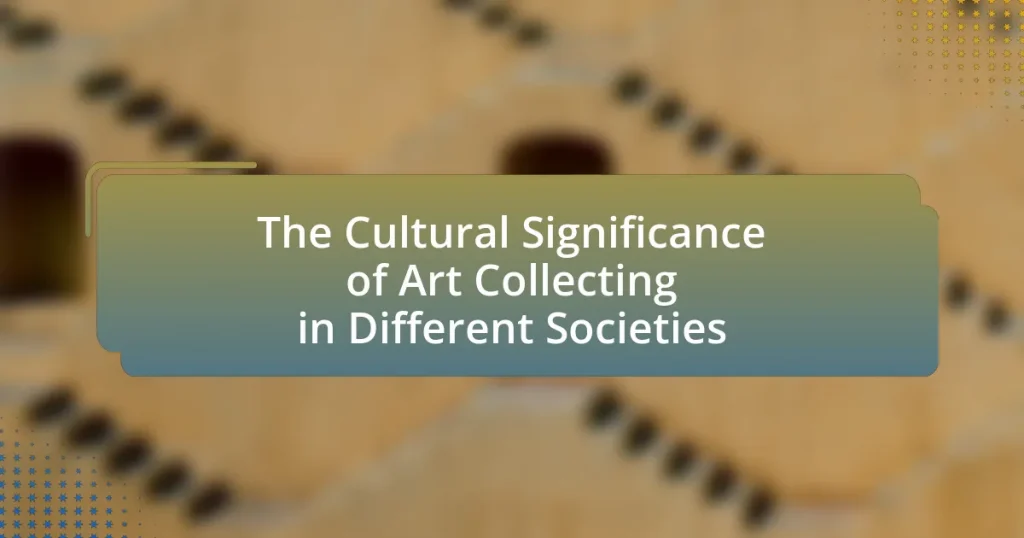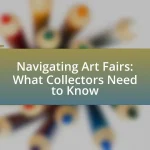Art collecting is a culturally significant practice that varies across societies, reflecting identity, status, and historical continuity. The article explores how art collections symbolize wealth and power, foster community heritage, and serve as a means of cultural diplomacy. It examines the relationship between art collecting and cultural values, the role of art in expressing identity, and the influence of cultural narratives on collecting practices. Additionally, it addresses the motivations behind art collecting, the impact of globalization, and the ethical considerations collectors must navigate, including provenance and cultural sensitivity. Through this analysis, the article highlights the multifaceted role of art collecting in preserving cultural heritage and shaping societal dynamics.
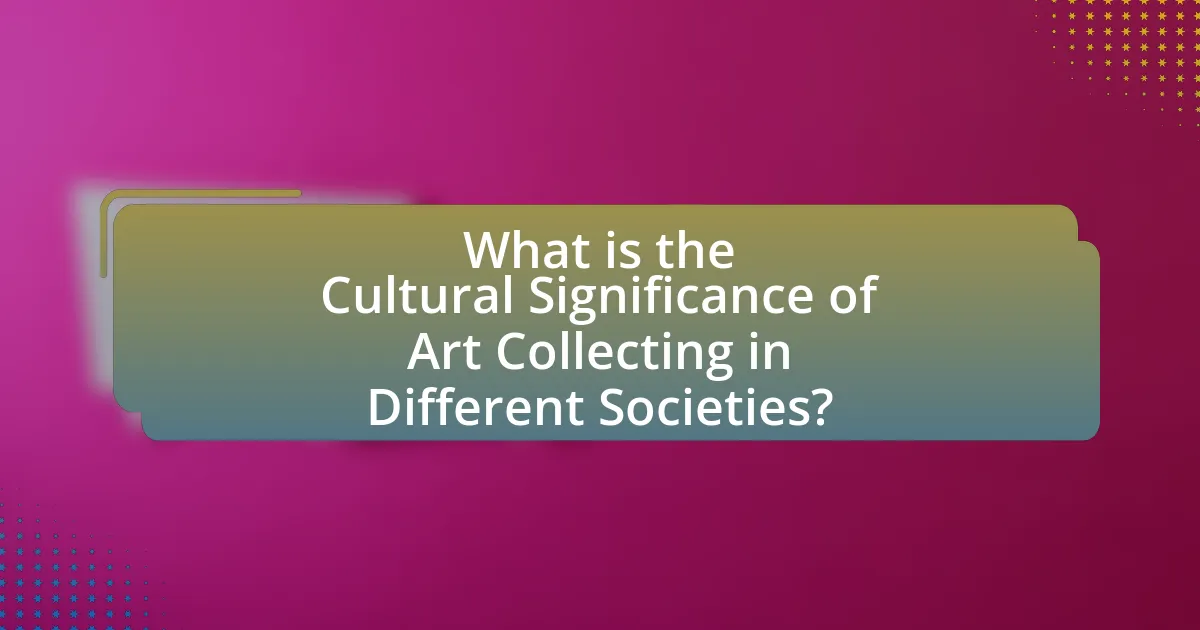
What is the Cultural Significance of Art Collecting in Different Societies?
Art collecting holds significant cultural value across various societies, serving as a reflection of identity, status, and historical continuity. In many cultures, art collections symbolize wealth and power, as seen in the European aristocracy, where owning masterpieces was a mark of prestige. Additionally, art collecting fosters community and cultural heritage, as indigenous societies often collect and preserve artifacts that embody their traditions and narratives. For instance, the Maasai of Kenya and Tanzania collect beadwork that represents their cultural identity and social status. Furthermore, art collections can act as a means of cultural diplomacy, where nations showcase their artistic heritage to promote understanding and cooperation, exemplified by international art exhibitions like the Venice Biennale. Thus, art collecting is not merely an individual pursuit but a vital cultural practice that shapes and reflects societal values and histories.
How does art collecting reflect cultural values?
Art collecting reflects cultural values by serving as a tangible representation of societal priorities, beliefs, and historical narratives. For instance, the types of art that individuals or institutions choose to collect often highlight what is deemed significant within a culture, such as national identity, social issues, or aesthetic preferences. In the 20th century, the rise of modern art collections in Western societies illustrated a shift towards valuing innovation and individual expression, while traditional art collections in other cultures may emphasize heritage and communal narratives. Furthermore, art collecting can also indicate economic status and access to cultural capital, as seen in the growing market for contemporary art, which often correlates with wealth and globalization trends.
What role does art play in expressing identity within societies?
Art serves as a vital medium for expressing identity within societies by reflecting cultural values, beliefs, and historical narratives. Through various forms such as painting, sculpture, and performance, art encapsulates the unique experiences and perspectives of different communities. For instance, Indigenous art often conveys ancestral stories and spiritual connections to the land, reinforcing cultural identity and continuity. Additionally, art movements like the Harlem Renaissance highlighted the African American experience, fostering a sense of pride and community identity during a time of social upheaval. These examples illustrate how art not only represents individual and collective identities but also plays a crucial role in shaping societal perceptions and fostering dialogue about cultural heritage.
How do cultural narratives influence art collecting practices?
Cultural narratives significantly influence art collecting practices by shaping the values, preferences, and motivations of collectors. These narratives often reflect historical, social, and political contexts that inform what is deemed valuable or meaningful in art. For instance, in societies where indigenous heritage is celebrated, collectors may prioritize works that represent native artists or traditional techniques, thereby reinforcing cultural identity and continuity. Additionally, art movements, such as the Harlem Renaissance, have led collectors to seek works that embody the cultural and social struggles of specific communities, thus promoting awareness and appreciation of those narratives. This alignment between cultural narratives and art collecting is evident in the increasing market demand for artworks that tell stories of marginalized groups, as seen in the rise of contemporary art fairs focusing on diversity and inclusion.
Why do societies engage in art collecting?
Societies engage in art collecting primarily to preserve cultural heritage and express identity. Art collecting serves as a means to document historical narratives, reflect societal values, and foster community pride. For instance, museums and private collectors often acquire artworks that represent significant cultural milestones, thereby ensuring that future generations can access and appreciate their history. Additionally, art collecting can stimulate economic growth through tourism and the art market, as seen in cities like Paris and New York, where art institutions attract millions of visitors annually. This multifaceted engagement with art underscores its role as a vital component of societal development and cultural continuity.
What are the historical motivations behind art collecting?
The historical motivations behind art collecting include status, investment, and cultural preservation. Throughout history, individuals and institutions have collected art to demonstrate wealth and social standing, as seen in the Renaissance when affluent patrons commissioned works to showcase their power and taste. Additionally, art has been viewed as a financial investment; for example, during the 19th century, collectors recognized the potential for art to appreciate in value, leading to the establishment of art markets. Furthermore, the desire to preserve cultural heritage has driven collections, as evidenced by museums and private collectors acquiring works to safeguard artistic legacies for future generations.
How does art collecting serve as a status symbol in various cultures?
Art collecting serves as a status symbol in various cultures by reflecting wealth, taste, and cultural capital. In societies such as the United States and Europe, owning high-value artworks often signifies financial success and social prestige, as seen in the auction prices of works by renowned artists like Picasso or Van Gogh, which can reach millions. Additionally, in cultures like China, art collecting is intertwined with traditional values, where owning classical Chinese paintings or calligraphy is associated with education and refinement, further enhancing one’s social standing. The presence of art in personal spaces, such as homes or galleries, communicates a collector’s sophistication and cultural awareness, reinforcing their status within their community.
What are the different forms of art collecting across cultures?
Art collecting varies significantly across cultures, reflecting diverse values, traditions, and historical contexts. In Western cultures, art collecting often emphasizes individualism and personal expression, with collectors acquiring pieces for aesthetic appreciation or investment, as seen in the rise of private galleries and auction houses since the 18th century. In contrast, many Indigenous cultures prioritize communal ownership and cultural heritage, where art serves as a means of preserving traditions and storytelling, evident in the collective practices of Native American tribes.
In East Asian cultures, particularly in China, art collecting is deeply intertwined with status and scholarly pursuits, with collectors often focusing on calligraphy and traditional paintings that embody philosophical ideals. African art collecting frequently emphasizes ritualistic and functional aspects, where artworks are integral to ceremonies and community identity, as observed in the use of masks and sculptures in various tribal practices.
These forms of art collecting illustrate how cultural significance shapes the motivations and practices of collectors worldwide, highlighting the interplay between art, identity, and societal values.
How do traditional and contemporary art collecting differ?
Traditional art collecting primarily focuses on historical significance, established artists, and classical techniques, while contemporary art collecting emphasizes current trends, emerging artists, and innovative practices. Traditional collectors often seek works that reflect cultural heritage and historical narratives, valuing provenance and authenticity, as seen in the collections of museums and private estates. In contrast, contemporary collectors are more inclined to support living artists and experimental forms, often participating in art fairs and auctions that highlight new movements. This shift reflects broader societal changes, where contemporary art collecting is increasingly seen as a dynamic investment and a means of personal expression, contrasting with the more conservative approach of traditional art collecting.
What types of art are most commonly collected in different societies?
Different societies commonly collect various types of art, including traditional crafts, contemporary art, and indigenous artworks. For instance, in Western societies, contemporary art and modernist pieces are prevalent, reflecting current cultural trends and values. In contrast, Asian societies often emphasize traditional art forms, such as calligraphy and ceramics, which hold historical significance and cultural heritage. Indigenous communities frequently collect and preserve artworks that represent their cultural identity, such as totem poles and woven textiles. This diversity in art collection reflects the unique cultural values and historical contexts of each society, as evidenced by the increasing global interest in both contemporary and traditional art forms.
How does art collecting impact social dynamics?
Art collecting significantly impacts social dynamics by fostering community engagement and establishing social hierarchies. Collectors often create networks that facilitate interactions among individuals with shared interests, leading to the formation of exclusive social circles. For instance, art fairs and gallery openings serve as venues for networking, where collectors, artists, and critics converge, enhancing social capital. Additionally, the value placed on certain artworks can reinforce social status; owning prestigious pieces often elevates an individual’s standing within society. Research indicates that art collectors frequently influence cultural trends and public discourse, as their choices can shape collective tastes and preferences. This interplay between art collecting and social dynamics illustrates how cultural practices can reflect and reinforce societal structures.
What challenges do art collectors face in different cultural contexts?
Art collectors face challenges such as differing cultural values, legal restrictions, and market dynamics in various cultural contexts. For instance, in some cultures, art may be viewed primarily as a communal asset rather than an individual possession, complicating ownership and collection practices. Additionally, legal frameworks regarding art provenance and export laws can vary significantly; for example, countries like Italy have stringent laws protecting cultural heritage, which can hinder international sales. Furthermore, market dynamics differ, as collectors in emerging markets may encounter less established networks and higher risks of forgery, impacting their ability to acquire authentic works. These factors collectively create a complex landscape for art collectors navigating diverse cultural environments.
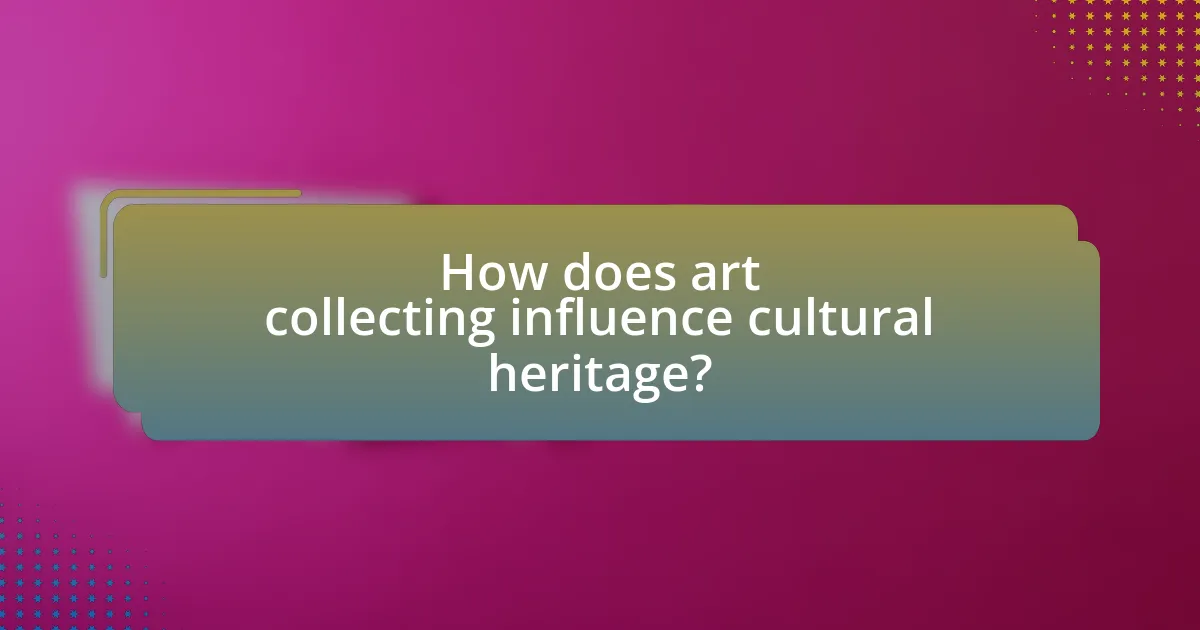
How does art collecting influence cultural heritage?
Art collecting significantly influences cultural heritage by preserving and promoting artistic expressions that reflect societal values and historical contexts. Collectors often acquire works that embody the cultural narratives of specific communities, thereby ensuring that these narratives are maintained and shared across generations. For instance, the collection of indigenous art not only supports the artists but also fosters awareness and appreciation of the cultural traditions and histories of those communities. Furthermore, art collections in museums and galleries serve as educational resources, allowing the public to engage with diverse cultural heritages, as seen in institutions like the Smithsonian National Museum of the American Indian, which showcases Native American art and culture. This active engagement helps to sustain cultural identities and encourages dialogue about cultural diversity and heritage preservation.
What role does art collecting play in preserving cultural history?
Art collecting plays a crucial role in preserving cultural history by safeguarding and showcasing artifacts that reflect the values, beliefs, and experiences of different societies. Through the acquisition and curation of artworks, collectors contribute to the documentation of cultural narratives and historical contexts, ensuring that these stories are accessible to future generations. For instance, museums and private collections often house pieces that represent significant cultural movements or historical events, such as the Harlem Renaissance or Indigenous art, which serve as educational resources and cultural touchstones. This preservation effort is vital for maintaining cultural identity and fostering appreciation for diverse heritages.
How do collectors contribute to the documentation of cultural narratives?
Collectors contribute to the documentation of cultural narratives by preserving and curating artifacts that reflect the values, beliefs, and histories of specific communities. Through their collections, they create a tangible record of cultural expressions, enabling future generations to understand and appreciate diverse cultural identities. For instance, the collection of indigenous art by collectors has played a crucial role in documenting the traditions and stories of indigenous peoples, often leading to increased awareness and appreciation of their cultural heritage. This preservation effort is supported by studies showing that collections can serve as educational resources, fostering cultural dialogue and understanding among different societies.
What are the implications of art repatriation for cultural heritage?
Art repatriation has significant implications for cultural heritage, primarily by restoring ownership and access to cultural artifacts to their countries of origin. This process acknowledges historical injustices, such as colonialism and looting, which have often resulted in the displacement of cultural property. For instance, the return of the Elgin Marbles to Greece from the British Museum would not only restore a vital part of Greek heritage but also enhance national identity and cultural pride. Furthermore, repatriation fosters cultural preservation, allowing communities to maintain their traditions and narratives associated with these artifacts. Studies indicate that repatriated items can lead to increased tourism and educational opportunities, thereby benefiting local economies and cultural institutions.
How does globalization affect art collecting practices?
Globalization significantly influences art collecting practices by expanding access to diverse artworks and fostering cross-cultural exchanges. As international markets become interconnected, collectors can acquire pieces from various cultures, enhancing the diversity of their collections. For instance, the rise of online platforms and global art fairs has made it easier for collectors to discover and purchase art from artists worldwide, breaking geographical barriers. Additionally, globalization has led to increased collaboration among artists, curators, and collectors, resulting in a more inclusive art scene that reflects a multitude of cultural perspectives. This shift is evidenced by the growing prominence of non-Western artists in major art institutions and auctions, indicating a broader appreciation for global artistic expressions.
What are the effects of cross-cultural exchanges on art collections?
Cross-cultural exchanges significantly enrich art collections by introducing diverse artistic styles, techniques, and cultural narratives. These exchanges foster innovation and creativity, as seen in the incorporation of African motifs in European modernist art during the early 20th century, which led to movements like Cubism. Additionally, cross-cultural interactions often result in the blending of traditions, exemplified by the fusion of Eastern and Western art forms in contemporary installations. Such diversity not only enhances the aesthetic value of collections but also promotes cultural understanding and appreciation among different societies.
How do international art markets shape local collecting habits?
International art markets significantly influence local collecting habits by introducing global trends and standards that local collectors often aspire to emulate. This influence manifests through increased access to international artists and artworks, which can elevate local collectors’ expectations regarding quality and investment potential. For instance, the rise of online platforms like Artsy and Saatchi Art has made it easier for local collectors to discover and purchase works from international artists, thereby broadening their collecting scope. Additionally, the presence of international galleries and auction houses in local markets often sets higher price points and establishes a benchmark for local art valuation, compelling collectors to adapt their purchasing strategies accordingly. This dynamic can lead to a homogenization of tastes, where local collectors gravitate towards styles and artists that are trending on the global stage, thus reshaping the local art landscape.
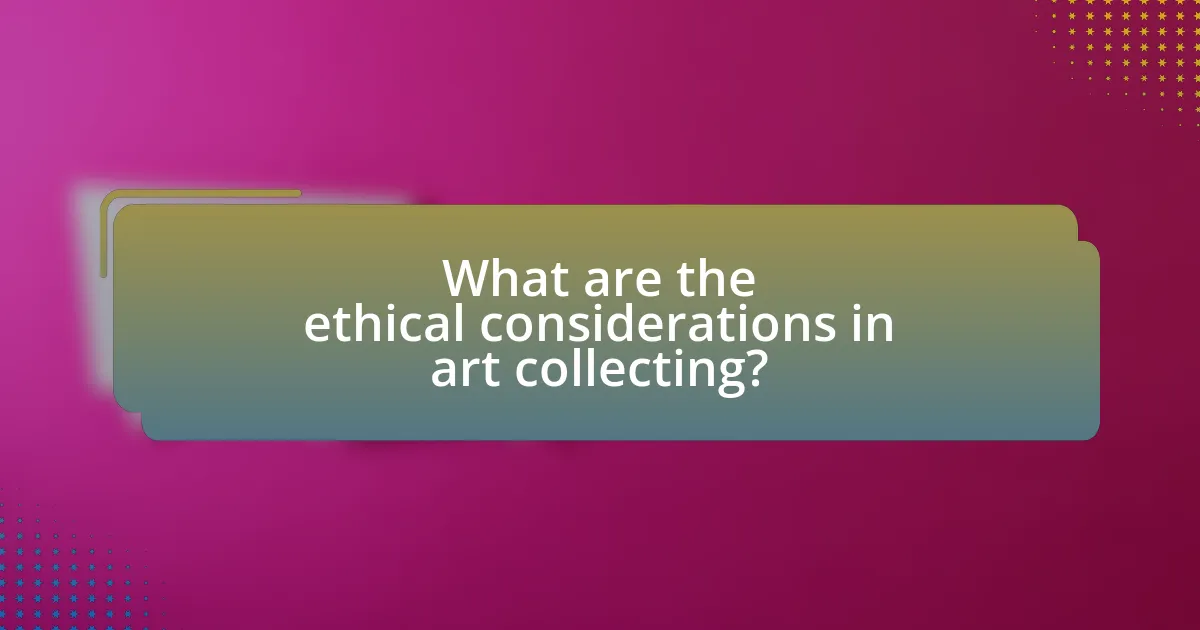
What are the ethical considerations in art collecting?
The ethical considerations in art collecting include provenance, cultural sensitivity, and the impact on artists and communities. Provenance refers to the history of ownership of an artwork, which is crucial to ensure that the piece was acquired legally and ethically, preventing the support of art theft or looting. Cultural sensitivity involves recognizing and respecting the cultural significance of artworks, particularly those from marginalized communities, to avoid exploitation or appropriation. Additionally, the impact on artists and communities must be considered, as art collecting can influence market dynamics and access to resources for creators. These considerations are essential for fostering a responsible and respectful art collecting practice.
How do collectors navigate issues of provenance and authenticity?
Collectors navigate issues of provenance and authenticity by conducting thorough research and utilizing expert verification services. They often trace the history of an artwork through documentation, such as invoices, exhibition catalogs, and previous ownership records, to establish its legitimacy. Additionally, collectors may employ third-party authentication services that specialize in verifying the authenticity of artworks, which can include scientific analysis and expert opinions. Provenance research is crucial, as it not only confirms authenticity but also enhances the artwork’s value; for instance, artworks with well-documented histories often command higher prices in the market.
What are the legal implications of art ownership and acquisition?
The legal implications of art ownership and acquisition include issues related to title, provenance, copyright, and potential restitution claims. Ownership of art requires clear title, meaning the buyer must ensure that the seller has the legal right to sell the artwork, which is often verified through provenance documentation. Provenance establishes the history of ownership and can affect the artwork’s value and legality; for instance, art acquired during wartime or through theft may be subject to restitution claims by original owners or their heirs. Additionally, copyright laws protect the rights of artists, meaning that even if one owns a physical piece of art, the reproduction rights may still belong to the artist or their estate. These legal frameworks are essential for ensuring that art transactions are legitimate and that ownership rights are respected.
How can collectors ensure ethical practices in their collections?
Collectors can ensure ethical practices in their collections by conducting thorough provenance research to verify the history and ownership of each item. Provenance research helps collectors confirm that artworks and artifacts were acquired legally and ethically, thereby avoiding items that may have been looted or stolen. For instance, the 1970 UNESCO Convention emphasizes the importance of provenance in preventing the illicit trade of cultural property, highlighting that collectors should seek documentation that traces an item’s ownership history. Additionally, collectors can engage with reputable galleries and auction houses that adhere to ethical standards, ensuring that their acquisitions comply with legal and moral guidelines.
What best practices should art collectors follow?
Art collectors should conduct thorough research on artists and artworks before making purchases. This practice ensures informed decisions, as understanding an artist’s background, market trends, and the artwork’s provenance can significantly impact value and appreciation. For instance, a study by the Art Market Research in 2020 indicated that artworks with verified provenance tend to appreciate in value by an average of 20% more than those without. Additionally, collectors should maintain proper documentation and insurance for their collections to protect their investments and ensure authenticity. This approach not only safeguards the collector’s assets but also enhances the collection’s credibility in the art market.
How can collectors build meaningful relationships with artists and communities?
Collectors can build meaningful relationships with artists and communities by actively engaging in dialogue and supporting their work. This involves attending exhibitions, participating in artist talks, and providing constructive feedback, which fosters a sense of collaboration and mutual respect. Additionally, collectors can contribute to community initiatives, such as funding local art programs or collaborating on projects that highlight cultural narratives, thereby strengthening ties with both artists and the broader community. Research indicates that such engagement not only enhances the visibility of artists but also enriches the cultural fabric of society, as seen in initiatives like the Art for Change program, which connects collectors with emerging artists to promote social impact through art.
What resources are available for new art collectors to educate themselves?
New art collectors can educate themselves through various resources, including books, online courses, art fairs, and museum programs. Books such as “The Art of Buying Art” by Maxine Hujer and “Collecting Art for Dummies” provide foundational knowledge on art collecting. Online platforms like Coursera and MasterClass offer courses on art appreciation and collecting strategies. Art fairs, such as Art Basel and Frieze, allow collectors to engage directly with artists and galleries, enhancing their understanding of the market. Additionally, many museums offer workshops and lectures that cover topics related to art history and collecting, providing practical insights into the art world.










